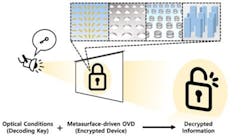Researchers in South Korea are working to aid anticounterfeiting and security applications, with the help of devices driven by optics.
A team at Pohang University of Science and Technology (POSTECH) has found that metasurfaces—2D arrays of subwavelength structures known as meta-atoms, which allows light to be freely controlled by arranging nanostructures in a desired shape—can assist with the international problem of anticounterfeiting (see figure). According to the researchers, optical indicators such as optically variable devices (OVDs) “are in tremendous demand” to combat this growing threat.
In their study, published in Chemical Reviews, the team found that metasurfaces have the potential to lead a new generation of OVDs, “as they exhibit exceptional behaviors that can provide a more robust solution for optical anticounterfeiting.” Metasurface-based optical devices can store more than 100X more information than conventional methods, such as a rainbow hologram sticker, and subsequently “selectively display a desired image based on angle, color, and polarization.”
Unlike traditional OVDs—which are more commonly subjected to security dangers (including fraudulent replication of money, documents, etc.) thanks to advances in printing technology and widespread copying methods of security features—metasurface-driven OVDs can have multiple optical responses in a single device, “making them difficult to be reverse-engineered” or replicated. In addition, such a device is favored given its very small size; it can also be mass-produced at low cost, according to the researchers.
“Security labels made using metasurfaces are difficult to replicate and are highly secure since they cannot be decrypted without specific settings,” says researcher Junsuk Rho, an associate professor at POSTECH. He adds that “encrypted information can never be decrypted without the correct optical decryption.” Encrypting information in a specific order, the study notes, makes it possible to separately store images and see them without special equipment, including that which allows images to be viewed only with “specific analysis equipment by security professionals.”
Metasurface OVDs have been used in ultrahigh-resolution structural color printing, various types of holography, and polarization encoding.
About the Author
Justine Murphy
Multimedia Director, Digital Infrastructure
Justine Murphy is the multimedia director for Endeavor Business Media's Digital Infrastructure Group. She is a multiple award-winning writer and editor with more 20 years of experience in newspaper publishing as well as public relations, marketing, and communications. For nearly 10 years, she has covered all facets of the optics and photonics industry as an editor, writer, web news anchor, and podcast host for an internationally reaching magazine publishing company. Her work has earned accolades from the New England Press Association as well as the SIIA/Jesse H. Neal Awards. She received a B.A. from the Massachusetts College of Liberal Arts.

